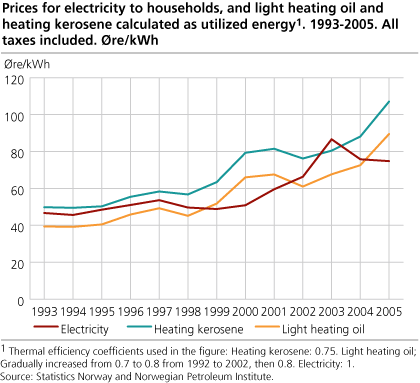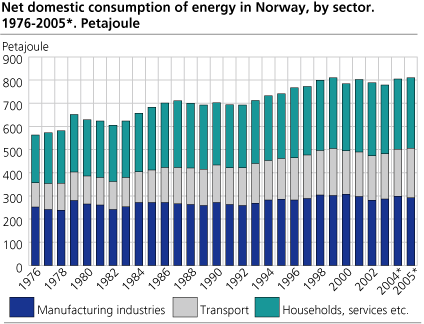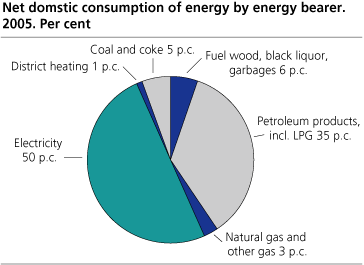Content
Published:
This is an archived release.
Record high consumption of electricity
The total domestic energy consumption rose by 0.5 per cent from 2004 to 2005. The consumption of electricity rose by 2 per cent to 112 TWh and has never been higher, while the use of oil products to heating and industrial purposes was reduced. However, the consumption of petroleum products for transport purposes rose considerably.
The increase in electricity consumption in 2005 is partly due to higher oil product prices due to a significant rise in prices on crude oil. The prices on heating oil and heating kerosene rose by 22 and 20 per cent respectively from 2004 to 2005, while the electricity prices was somewhat reduced for most consumer groups. Consumption of heating oils and heating kerosene dropped considerably from 2004 to 2005. At the same time, consumption of transport oils, as marine gas oils, auto diesel and jet fuel rose, in spite of price rise also on these products. The total consumption of petroleum products was not changed compared with 2004.
Low compared with GDP
The growth in energy consumption is connected with the economic growth because higher production can imply higher energy consumption. However, the growth in energy consumption was pretty low compared with the growth in GDP that was 3.7 per cent for mainland-Norway due to preliminary figures from National Accounts. Higher energy prices, and the fact that 2005 was warmer than normal, can have contributed to limit the growth in energy consumption. The temperature was 1.5 degrees centigrade higher than the climatic normal for the year 1961-1990, according to the Meteorological Institute. 2005 is the sixth warmest year since this statistics started in 1867, and it was 0.1 degree centigrade warmer than the previous year.
The total energy consumption in 2005 was 810 Petajoule, corresponding to 225 TWh. Half of this was electricity, while 79 TWh (35 per cent) was petroleum products. Consumption of coal, coke, biomass, gas and district heating made up the remaining 15 per cent. Statistics for consumption of district heating and biomass is not yet available for 2005, and the 2004-figures are used as estimates on this.
Less oil to heating, but more to transport.
Only about 25-30 per cent of the oil consumption is used for heating or industrial production purposes that can be replaced by other energy sources. The main part goes to transport purposes that are less flexible in the choice of energy bearer. However, it's possible to change between different oil products. For example, the use of gasoline has been reduced since 2001 while the use of auto diesel is steadily increasing. This can be attributed to the fact that auto diesel is somewhat cheaper than gasoline, and that the sale of diesel cars has been higher than the sale of gasoline cars. In 2005 the consumption of gasoline fell by 4 per cent from the previous year, while the total consumption of energy to transport purposes rose by 5 per cent.
Total energy consumption in the sector "services, households etc." was approximately the same in 2005 as in 2004, but electricity consumption rose by about 3 per cent while petroleum products dropped by 14 per cent.
The energy consumption in manufacturing industries fell by about 2 per cent from 2004 to 2005. As in the service- and households sector, oil products were replaced by electricity. Electricity consumption rose by 1 per cent while use of petroleum products was reduced. The use of coke for non-energy purposes was also significantly reduced, and the total coal consumption fell by 15 per cent. The energy consumption for manufacturing industries is somewhat uncertain until final figures are available (during the summer 2006).
Tables:
The statistics is now published as Production and consumption of energy, energy balance and energy account.
Additional information
The statistics are published in spring and autumn. The spring publication is preliminary and aggregated to a larger degree, and only includes figures for energy balance. In the autumn publication, tables are also presented for the energy accounts.
Contact
-
Statistics Norway's Information Centre
E-mail: informasjon@ssb.no
tel.: (+47) 21 09 46 42



